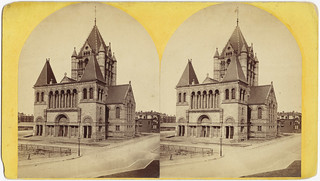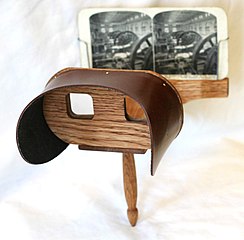From the Greek “stereo” (“solid”) and opsis (“power of
sight”) stereopsis is perceiving depth, relief, or three-dimensions (stereopsis,
n., 2012). This ability is most commonly due to binocular vision, where the
spacing of two eyes creates separate images of a scene from slightly different
angles, which are then combined into one vision with three-dimensional quality in
the brain.
The application of three-dimensional vision to
two-dimensional images, by using a viewing implement, or a stereoscope, was first described by English physicist Charles
Wheatstone in 1838. He created his stereoscope with prisms and mirrors, and it
was originally used for viewing drawings.
 |
| Wheatstone stereoscope. Retrieved from http://en.wikipedia.org/wiki/Stereoscope |
Scottish physicist David Brewster improved the stereoscope
in 1849, inventing the “refracting” or “Lenticular” stereoscope, which was
reduced in size and used lenses instead of mirrors. He also invented the double
camera for taking stereoscopic views, which were afterwards mostly produced
with such double-lensed cameras.
These photographs were produced as stereographs, with two images side by side. Stereographs are a
photographic format, not process, and were produced using multiple technical
processes over time, including the daguerreotype, ambrotype, wet plate glass
positive, mounted salted paper print, albumen prints, and gelatin print
processes (Ritzenthaler & Vogt-O’Connor, 2006, p. 41). The majority of
stereographs, also called stereo views, were mounted on cards.
 |
| Folson, A. H. (c.1850-1929). Trinity Church, Boston. Retrieved from http://www.flickr.com/photos/boston_public_library/2351548106/in/set-72157604192771132 |
Daguerreotype stereographs were first publically exhibited
in 1851 at the London International Exhibition, and were received enthusiastically
by Queen Victoria and others (history of photography, 2013). Their popularity
grew even more with the simple hand-held version of the stereoscope developed by
Oliver Wendell Holmes in 1861. Holmes’ invention, which was easy to
manufacture, combined with his excited promotion of stereoscopes and
stereographs in The Atlantic, helped
to boost the already popular form in the United States.
 |
| Holmes stereoscope. Retrieved from http://en.wikipedia.org/wiki/Stereoscope |
Stereographs were extremely popular from 1850
through the 1920s and 1930s (the rise of newsreels), and during this period
millions of stereographs were produced.
Photographers were sent out to photograph the world, and manufacturing the
views was a big business. One of the first firms to produce stereographs was
that of the Langenheim brothers, and later the leading publishers were
Underwood & Underwood and the Keystone Company. Views could be bought
individually, or more often, in large topical groups.
Stereoscopes became a popular instrument for home
entertainment and education (much like radio, and then TV) and had an important
impact on public knowledge and taste. Holmes was correct in his statement
regarding the stereograph that, “Men will hunt all curious, beautiful, grand
objects,” as the market for stereographs was expansive, and diverse (1859).
Images captured local history, grand landscapes, foreign scenes, important
people, architecture, war, disasters, and later on, staged scenes of humor and
the home. Curiosity about the world was a huge force in stereographic
popularity, and travel images as souvenirs, and of places one might never see,
were very popular.
 |
| Norman Rockwell painting of a boy viewing Egypt through his stereoscope. Retrieved from http://en.wikipedia.org/wiki/File:Rockwellboywithstereoscope.png |
The expansion of the business of stereographs and their broad
popularity not only impacted those directly involved, but also had an indirect
impact on other branches of photography and visual theory at the time. Holmes
not only wrote of the curious and beautiful objects available in stereographs,
but also noted that “form is [now] cheap and transportable” (1859). Whether intentional or not, this idea
was felt by those who saw in the stereograph (especially by the end of the
century when stereographic photography had become quite uniform,) the
cheapening of photography into popular commercialism. While these images
would inform the conventions of publicity and advertisement photography in the
future, they also pushed some photographers into “High Art” in response to
“stereoscopic trash” (Jeffrey, 1981, p. 38).
Despite these other opinions, and the branching out of new
forms in reaction to stereographs, it should be clear that stereographs hold
great importance for cultural heritage institutions who might seek to collect,
preserve, and offer access to these images. The broad use of stereographs in
everyday residential life during these decades, along with the diversity of
tastes and communities served by different stereograph subjects, has a strong
impact on their usefulness for researchers in a number of fields. Their
cultural currency is obvious in terms of looking at mass media, middleclass
households, education, and the images themselves are rich in visual and
contextual information, covering topographic views, local history, events,
industries and trade, costume, urban and country life, humor, and portraits.
They are also important for researching the history of photography itself,
having been produced by multiple processes (stereoscopic
photography,
2013). Preservation of stereographs is accordingly diverse, depending on the
process by which they were made.
Stereographs and stereoscopes form an early node in the
history and technology of three-dimensional viewing. Anyone who played with a
slide-viewer growing up, crossed their eyes at a "Magic Eye, or enjoyed 3D
at the movies has taken part in this history.
References
Jeffrey, I. (1981). Photography:
A concise history. New York: Oxford University Press.
Ritzenthaler, M. L. & Vogt-O’Connor, D. (2006). Photographs: Archival care and management.
Chicago: Society of American Archivists.
Additional Resources
The Getty Museum has produced a nice
simulation
of stereo viewing.
The Center for Civil War Photography, 3-D Anaglyph
Photography Exhibit:
http://www.civilwarphotography.org/3-d-anaglyph-photographs-exhibit















